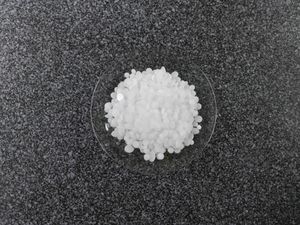Magnesium nitrate
 Magnesium nitrate fertilizer on a watchglass
| |
| Names | |
|---|---|
| IUPAC name
Magnesium nitrate
| |
| Other names
Magnesium dinitrate
Nitric acid, magnesium salt Nitromagnesite | |
| Properties | |
| Mg(NO3)2 (anhydrous) Mg(NO3)2·2 H2O (dihydrate) Mg(NO3)2·6 H2O (hexahydrate) | |
| Molar mass | 148.32 g/mol (anhydrous) 184.35 g/mol (dihydrate) 256.41 g/mol (hexahydrate) |
| Appearance | White hygroscopic solid |
| Odor | Odorless |
| Density | 2.3 g/cm3 (anhydrous) 2.0256 g/cm3 (dihydrate) 1.464 g/cm3 (hexahydrate) |
| Melting point | 129 °C (264 °F; 402 K) (dihydrate) 88.9 °C (192.0 °F; 362.0 K) (hexahydrate) |
| Boiling point | 330 °C (626 °F; 603 K) (decomposition) |
| 42 g/100 ml (20 °C) 71.2 g/100 ml (25 °C) | |
| Solubility | Soluble in ethanol |
| Vapor pressure | 0.494 mmHg at 25 °C |
| Hazards | |
| Safety data sheet | Sigma-Aldrich (hexahydrate) |
| Flash point | Non-flammable |
| Lethal dose or concentration (LD, LC): | |
| LD50 (Median dose)
|
5,440 mg/kg (rat, oral) |
| Related compounds | |
| Related compounds
|
Calcium nitrate Strontium nitrate Barium nitrate |
| Except where otherwise noted, data are given for materials in their standard state (at 25 °C [77 °F], 100 kPa). | |
| Infobox references | |
Magnesium nitrate is a hygroscopic magnesium salt, with the formula Mg(NO3)2, widely used as fertilizer.
Contents
Properties
Chemical
Heating magnesium nitrate will cause it to lose water, but it's extremely difficult to convert it into anhydrous form, as it decomposes to release nitrogen oxides, leaving behind magnesium oxide.
- 2 Mg(NO3)2 → 2 MgO + 4 NO2 + O2.
Physical
Magnesium nitrate is a hygroscopic white solid, which readily dissolves in water.
Availability
Magnesium nitrate is sold in many gardening stores as magnesium and nitrogen fertilizer (11-0-0 0-9.6), which is the hexahydrated form, and it's fairly pure. Magnesium nitrate is also found in other magnesium fertilizers, where it's mixed with other compounds. Purification is required to obtain this compound, though removing the water is difficult, as the salt tends to decompose at high temperatures.
Lastly, it can be purchased from chemical suppliers.
Preparation
Can be prepared by mixing magnesium sulfate, aka Epsom salt with calcium nitrate.
- MgSO4 + Ca(NO3)2 → Mg(NO3)2 + CaSO4
Filter off the insoluble calcium sulfate from the mixture to obtain a solution of Mg(NO3)2. To dry it, you will have to heat it gently on a water bath and then cool the concentrated solution. Use a seed crystal to obtain crystals of this compound and remove the excess water using vacuum.
Adding nitric acid to magnesium oxide, hydroxide or carbonate will give magnesium nitrate.
Anhydrous magnesium nitrate can be obtained by boiling the hydrated form in concentrated nitric acid, though this route has not been confirmed. Passing nitrogen dioxide through heated magnesium oxide at 100 °C should give magnesium nitrate anhydrous and nitric oxide. Another route would be to mix anhydrous calcium or barium nitrate dissolved in anhydrous methanol or ethanol, with anhydrous magnesium sulfate.
Projects
- Make nitrogen dioxide and nitric acid
- Anhydrous magnesium nitrate can be used to increase the concentration of nitric acid past its azeotrope
- Desiccant
Handling
Safety
Because of its hygroscopicity, magnesium nitrate cannot sustain an energetic mixture like potassium nitrate can, making it useful as a safe nitrate ion source. Skin contact with the anhydrous compound should be avoided as it can be irritating.
Storage
Magnesium nitrate should be kept in closed bottles, to prevent it from absorbing water from air and hardening.
Anhydrous Mg(NO3)2 should be kept in air-tight containers, or in a desiccator.
Disposal
No special disposal is required, can be safely used as fertilizer.